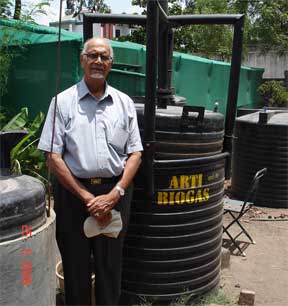The impending scarcity of petroleum threatens the world’s fuel supply. Mankind can face this threat successfully with the help of biogenous methane, but the world is yet to take full advantage of this technology, because its practitioners have so far ignore the basic tenet of science – viz. output of work is dependant on the energy available for doing that work. This fact is seen in the current practice of using low calorie inputs like cattle dung, distillery effluent, municipal solid waste or sewerage, in biogas plants, which makes methane generation highly inefficient. To rectify this skewed approach, in around 2003, Dr. Anand Karve (President of ARTI) developed a compact biogas system that uses starchy or sugary feedstock (waste grain flour, spoilt grain, overripe or misshapen fruit, nonedible seeds, fruits and rhizomes, green leaves, kitchen watse, leftover food, etc). Just 2 kg of such feedstock produces about 500 g of methane, and the reaction is completed with 24 hours. The conventional biogas systems, using cattle dung, sewerage, etc. use about 40 kg feedstock to produce the same quantity of methane, and require about 40 days to complete the reaction. Thus, from the point of view of conversion of feedstock into methane, the system developed by Dr. Anand Karve is 20 times as efficient as the conventional system, and from the point of view of reaction time, it is 40 times as efficient. Thus, overall, the new system is 800 times as efficient as the conventional biogas system.
To know how this technology works, click here.
Benefits
Most biogas plants which are currently in operation in India and elsewhere are designed for animal manure as their main feedstock, and are therefore used in rural areas. Whereas in cities, a majority of the people use LPG or kerosene for cooking. The immediate benefit from owning a compact biogas system is the savings in cost as compared to the use of kerosene or LPG for cooking. The up-front cost of a biogas system is higher than for LPG, since an LPG bottle plus a two burner stove costs only INR 5,000 (spprox. USD 100) whereas the compact biogas plan plus a biogas stove costs about INR 10,000 (approx. USD 200). However, the operational cost for biogas is only about INR 2 per day if waste flour is used as feedstock, and can be zero if the plant uses only food wastes. This is much cheaper than LPG, which costs about INR 30 per day, even with the current subsidy of 50%. Biogas can easily replace 50% of the LPG used by a family. Some families who use a pressure cooker for cooking and collect food waste from their neighbours have replaced all their LPG use.
Methane burns with a blue flame, without producing any smoke or soot. It is therefore an environmentally friendly cooking system. Thus, introduction of the new efficient, compact biogas system would not only help urban households in utilizing their domestic wet waste, but also help prevent millions of premature deaths of women and children in rural households due to indoor air pollution caused by smoke and soot from burning fuelwood in traditional chulhas. This markedly impacts the health of the people in the kitchen (mainly women) positively. Further reductions in pollution and energy use arise from not having to transport LPG cylinders to be re-filled. The small amount of solid residue produced by the biogas plant makes a good fertiliser.
On a global scale, it is well known that the replacement of fossil fuels reduces the emission of greenhouse gases. ARTI estimate that for a typical urban household, biogas saves 100 kg of LPG or 250 litres of kerosene per year, which is equivalent to 300 to 600 kg CO2 per year. A rural family could save about 3 tonnes of wood per year, which would generate about 5 tonnes CO2 if burnt.
Comparison with conventional Biogas plants
Biogas systems are those that take organic material (feedstock) into an air-tight tank, where bacteria break down the material and release biogas – a mixture of mainly methane with some carbon dioxide. The biogas can be burned as a fuel, for cooking or other purposes, and the solid residue can be used as organic compost.
The current practice of using low calorie inputs like cattle dung, distillery effluent, municipal solid waste, or sewerage, makes methane generation in conventional biogas plants highly inefficient. Through this compact system, it has been demonstrated that by using feedstock having high calorific and nutritive value to microbes, the efficiency of methane generation can be increased by several orders of magnitude. Operating the system on this simple tenet also brings in many more advantages over the conventional systems: As a result of the higher efficiency, the size and cost of the new system are also lower. While the conventional biogas system occupies about 4 cubic meters of space, the compact biogas system is about as large as a domestic refrigerator. It is an extremely user friendly system, because it requires daily only a couple of kg feedstock, and the disposal of daily just 5 litres of effluent slurry.
| Conventional Biogas Systems | ARTI Biogas system | |
| Amount of required feedstock | 40 kg + 40 lit water | 1-1.5 kg + 15 lit water |
| Nature of required feedstock | Dung | Any starchy material |
| Amount and Nature of slurry to be disposed of | 80 lit, sludge | 15 lit, watery |
| Reaction Time for full utilization of feedstock | 40 days | 48-72 hours |
| Standard size for household | 4000 lit | 1000-1500 lit |
| Capital Investment per unit including stove | INR 20,000 | INR 10,000 |
| Running Expenses per meal | INR 25 | 0 to INR 5 |
Establishing a new trend: Biogas in cities
In cities, waste food is often discarded and its rising heap attracts flies and rodents, thus creating a public health hazard. The compact biogas plant technology developed by ARTI readily accepts highly digestible organic materials such kitchen waste as feedstock and can easily blend into the urban lifestyle. A single plant produces sufficient biogas to at least halve the use of LPG or kerosene for cooking in a household, as well as a small amount of solid residue which can be used as fertiliser. ARTI’s compact biogas plant could be replicated anywhere where there is the space for the plant, and the temperature is sufficiently high.
This technology offers a solution not just for domestic waste disposal, but also for collective disposal of community waste. In villages, food waste was traditionally fed to animals or left by the side of the road for animals to devour. People continue to do this in cities but there are fewer animals to consume it. The result is that smelly, rotting food attracts flies and rats. Some authorities collect food waste and dispose of it in landfill. Here again, available land space presents its own constraints. For example: the authority in Pune has decided it can no longer dispose city waste in a landfill because of lack of space, and local officials are therefore strongly encouraging the use of biogas plants to dispose of food waste. Local council offices have set up demonstration plants, which use local food wastes and provide gas for making tea for local officials and their visitors.
Communities in city residential and commercial set-ups can avail this technology to convert starchy waste into clean useful energy.
Purchasing your own compact biogas system: Cost & Payment
ARTI’s trained technicians install the biogas plants using locally available plastic tanks (commonly used for water storage) and a plumbing kit supplied by Samuchit Enviro-Tech (SET) Pvt. Ltd., a company set up by members of ARTI. SET also supplies a single burned biogas stove made of cast iron, and a gas cock. This set, consisting of the plumbing kit and a single burner biogas stove, costs INR 2350 (M.R.P. inclusive of taxes and transport anywhere in India). The total estimated cost of the compact biogas system for a typical household (around 1000-1500 lit capacity) is about INR 10,000, but the actual cost may vary based on local prices of plastic tanks and local labour costs.
For more information, please contact us at arti_pune@vsnl.net .
Build your own ARTI Biogas Plant!
ARTI biogas plants can be built by following the instructions given in the ARTI Biogas VCD available here. For customers who cannot afford the transportation and installation costs of these large volume systems, the VCD provides the cheap option of a DIY (do-it-yourself) kind of project.
The design is not very complex and can be fabricated using locally available materials. In general the following parts would need to be obtained locally:
-
1000 Ltr and 750 Ltr plastic tanks. If not available then cement and brick tanks can be constructed.
-
PVC pipes of various diameters, commonly used in plumbing.
-
Biogas cookstove (This would generally be available in countries where the biogas technology has been promoted by the governments).
PVC pipes of required diameters and biogas cookstoves can also be obtained as a 'Biogas Kit' from Samuchit Enviro-Tech Pvt. Ltd., Pune. Many people around the world have successfully built ARTI's biogas plants by themselves. Also, we'll be there to help if you face any problems. Once you build this plant successfully, you can help you friends and neighbors in trying this very practical and appropriate technology!
What the numbers say
From 2003 onwards, about
1000 compact biogas plants have been so far installed by ARTI's trained
personnel – covering both rural as well as urban households in Maharashtra.
At least 1000 more plants have been installed by enthusiasts and hobbyists,
using the instruction VCD widely produced and distributed by ARTI (
click here for
more information on our VCDs and booklets). In Maharashtra, several
independent producers have copied the design for themselves. These existing
plants are a useful advertisement for the advantages of biogas systems and
consequently about 30-50 plants are now being installed per month.
In Maharashtra State alone, there are an estimated 500,000 potential users
for this technology. ARTI aims to reach out to these potential users and
more, with this revolutionary clean fuel technology. We also look to
manufacture standardised feedstock in de-centralised units to facilitate
ease in plant usage and set up sustainable entrepreneur chains for unit
supply and maintenance.



